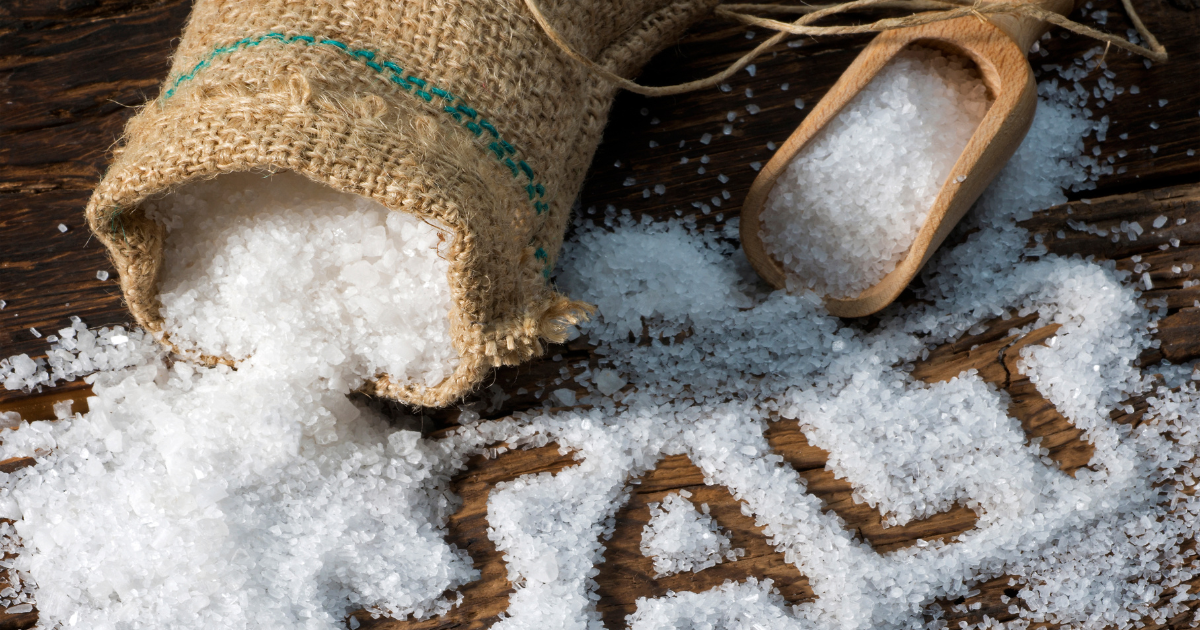Some researchers suggest that eating too little salt could be just as harmful as consuming too much. So, what’s the truth behind the low-salt diet debate?
Back in 2017, Turkish chef Nusret Gökçe, better known as Salt Bae, became an internet sensation after a viral video showed him dramatically sprinkling salt over a massive steak. The clip racked up millions of views and turned him into a global meme. But beyond the viral fame, it reignited conversations about how much salt we really need in our diets—and whether cutting back too much could put our health at risk.
#1We can’t seem to quit salt. Despite decades of health warnings
most people around the globe consume nearly double the recommended daily amount of sodium—and our health is paying the price. Yet, a growing counter-argument is challenging long-standing research, raising fresh questions about whether our favorite seasoning is truly the villain it’s made out to be.
Sodium—the main component of salt—isn’t just a flavor booster. It plays a vital role in maintaining fluid balance, oxygen transport, and nutrient delivery throughout the body. It even powers the tiny electrical impulses that keep our nerves firing. Still, while sodium is essential for survival, history shows that populations consistently consume far more than experts advise. And public health officials face an uphill battle convincing people to cut back on their salt intake.
#2How Much Salt Should You Really Have Each Day?
When it comes to salt, the numbers can be confusing. The World Health Organization (WHO) recommends keeping sodium intake under 2 grams per day—that’s about 5 grams of table salt (roughly a teaspoon).
In the United States, the Dietary Guidelines for Americans suggest a slightly higher limit of 2.3 grams of sodium per day, which is still close to just one teaspoon of salt.
But here’s where things get interesting: a 2022 study found that people who consumed a moderate amount of sodium—between 3 to 6 grams daily—actually had a lower risk of heart disease compared to those on very low-sodium or very high-sodium diets. This research is fueling the ongoing debate about whether cutting back too much on salt might be just as harmful as having too much.
#3How Much Salt Is Too Much? The Real Health Risks of High Sodium Intake
Guidelines from the NHS in the UK recommend adults consume no more than 6g of salt per day, including both the salt we add during cooking and the salt already hidden in processed foods. Yet, the reality is very different: the average daily salt intake in the UK is 8.4g, while in the US it’s about 8.5g. Globally, the World Health Organization (WHO) estimates average salt intake has climbed to nearly 10.8g per day—almost double the recommended amount.
Here’s the catch: only about 25% of our salt intake comes from what we add ourselves. The rest is hidden in packaged foods like bread, sauces, soups, processed meats, and even breakfast cereals. To make things more confusing, nutrition labels often list sodium instead of salt. Since 2.5g of salt contains roughly 1g of sodium, many consumers mistakenly believe they’re eating less salt than they actually are. As nutritionist May Simpkin puts it: “The general public isn’t aware of this. No one tells you sodium and salt aren’t the same thing.”
In the US, the CDC reports that around 40% of sodium intake comes from foods such as pizza, deli meats, burritos, tacos, savory snacks, poultry, and burgers.
The Hidden Dangers of Too Much Salt
The science is clear: excessive salt raises blood pressure, which in turn increases the risk of strokes, heart attacks, and kidney disease. When we eat too much salt, our bodies hold onto extra water, which raises blood pressure until the kidneys can flush it out. Over time, this strain damages arteries and leads to hypertension—a condition responsible for 62% of strokes and 49% of coronary heart disease events, according to the WHO.
The global impact is staggering: excess sodium is linked to 1.89 million deaths every year.
A meta-analysis of 13 long-term studies spanning 35 years found that eating just 5g of extra salt per day increases the risk of:
Cardiovascular disease by 17%
Stroke by 23%
#4The Health Benefits of Cutting Salt Intake
Lowering salt intake can have profound effects on cardiovascular health.
Population-level evidence:
An eight-year analysis of the Health Survey for England found that reducing salt intake by 1.4g/day was linked to lower blood pressure. This decline in blood pressure likely contributed to a 42% drop in fatal strokes and a 40% reduction in heart disease-related deaths.
Clinical evidence:
A 2023 trial showed that just one week on a low-sodium diet reduced blood pressure as effectively as a common hypertension medication.
Observational patterns:
It’s tricky to tease out salt’s effects in isolation, since people who watch their salt often also eat healthier, exercise, smoke less, and drink less. Still, the trend is consistent worldwide: when salt intake drops, so do rates of stroke and heart disease.
Historical examples:
Japan: A national campaign in the late 1960s reduced daily salt intake from 13.5g to 12g, with blood pressure falling and an 80% reduction in stroke deaths.
Finland: Between the late 1970s and 2002, daily salt intake dropped from 12g to 9g, while deaths from stroke and heart disease fell by 75–80%.
👥 Why Salt Affects Everyone Differently
Not all bodies react the same way to sodium.
Salt sensitivity: Some people’s blood pressure rises sharply with high salt intake, while others barely budge.
Factors that influence sensitivity:
Ethnicity (e.g., higher sensitivity in people of African descent)
Age (older adults are more vulnerable)
Body mass index (higher BMI tends to increase risk)
Health and family history of hypertension
This explains why a “one-size-fits-all” sodium guideline doesn’t fully capture reality: some people can tolerate more salt without harm, while others experience major blood pressure spikes even at moderate levels.
#5Some researchers now suggest that eating too little salt may be just as risky for blood pressure as eating too much
In other words, instead of a straight line, the relationship between salt intake and health looks more like a J- or U-shaped curve—where risk decreases up to a point, but then rises again if salt levels drop too low.
For example, a large meta-analysis found a clear link between low sodium intake and higher rates of cardiovascular disease and death. The researchers concluded that consuming less than 5.6g or more than 12.5g of salt per day can both lead to harmful health outcomes.
Similarly, a 2020 study revealed that strict salt restrictions were associated with worse outcomes in patients with heart failure—particularly among younger adults and non-white populations.
#6Another large study involving over 170,000 participants found similar results
Researchers reported that “low” salt intake—defined as less than 7.5g per day—was linked to higher risks of cardiovascular events and death, both in people with and without high blood pressure. In contrast, a “moderate” intake of up to 12.5g per day (about 1.5 to 2.5 teaspoons of salt) was associated with better health outcomes. Interestingly, this “moderate” level is nearly double the UK’s recommended daily intake.
The study’s lead author, Andrew Mente, a nutritional epidemiologist at McMaster University in Ontario, explained the takeaway: lowering salt from very high to moderate levels reduces the risk of hypertension—but cutting it further shows no additional health benefit. In fact, raising intake from very low to moderate may actually help.
As Mente put it, “The finding of a sweet spot in the middle is consistent with what you’d expect for any essential nutrient—too much leads to toxicity, too little to deficiency, and the optimal level lies somewhere in between.”
#7On one side you have researchers like Mente
who argue there’s a “sweet spot” of moderate intake (roughly 7–12 g salt a day) and that going too low may even be harmful. On the other, people like Cappuccio and Stanner who stick with the more traditional view: the lower the better, at least when it comes to blood pressure.
#8The disagreement boils down to:
Measurement methods: Most of the large studies (including Mente’s) estimate salt intake from spot urine samples, which critics say are less accurate than 24-hour urine collection (the gold standard). This difference can really change the picture.
Population differences: Many of the “low salt increases risk” findings come from groups already unwell (e.g. with kidney disease or heart failure), where low sodium might be a marker of poor health rather than the cause.
Practicality: As Stanner points out, hardly anyone in modern food environments eats as little as 3 g/day naturally. Most processed and restaurant foods are loaded with salt, so the public health goal is about lowering population averages, not hitting some perfect personal “sweet spot.”
Context matters: Potassium intake, weight, exercise, alcohol, and overall diet all influence how harmful sodium actually is. A person on a Mediterranean diet rich in fruit/veg and dairy, with high potassium, may tolerate more salt without the same blood pressure hit as someone eating lots of processed foods.
So — the tension is between population-level advice (keep salt low, because most people eat too much) and individual-level nuance (a healthy, active person may not benefit from pushing intake extremely low).
#9How Much Salt Is Too Much? The Debate Around Low-Sodium Diets
Ceu Mateus, a senior lecturer in Health Economics at Lancaster University, believes the key isn’t to cut salt out completely but to stay aware of hidden sodium in everyday foods.
“Too much salt is definitely harmful, but removing it entirely from your diet isn’t the answer either,” Mateus explains. “A healthy body can regulate small amounts, but the risks from very high or very low intake still need more research.”
A 2022 study supports this balanced view, suggesting that a moderate sodium intake of 3–6 grams per day is linked to the lowest risk of heart disease compared to both low- and high-salt diets.
So while scientists continue to debate the risks of eating too little salt, one fact is clear: excess sodium raises blood pressure. For now, the safest approach is moderation—keeping your salt levels in check without cutting it out completely.
Take the rest with, well… a pinch of salt.







